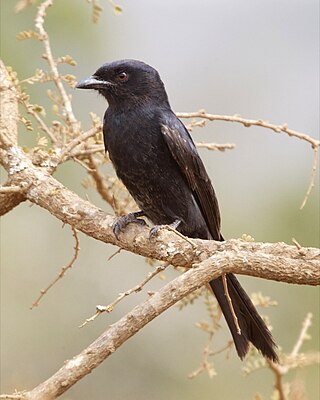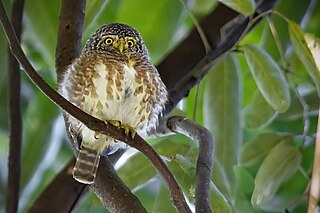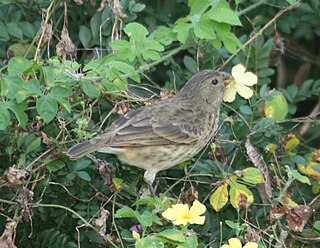
The dunlin is a small wader in the genus Calidris. The English name is a dialect form of "dunling", first recorded in 1531–1532. It derives from dun, "dull brown", with the suffix -ling, meaning a person or thing with the given quality.

The ruff is a medium-sized wading bird that breeds in marshes and wet meadows across northern Eurasia. This highly gregarious sandpiper is migratory and sometimes forms huge flocks in its winter grounds, which include southern and western Europe, Africa, southern Asia and Australia.

The Eurasian siskin is a small passerine bird in the finch family Fringillidae. It is also called the European siskin, common siskin or just siskin. Other (archaic) names include black-headed goldfinch, barley bird and aberdevine. It is very common throughout Europe and Eurosiberia. It is found in forested areas, both coniferous and mixed woodland where it feeds on seeds of all kinds, especially of alder and conifers.

The pine siskin is a North American bird in the finch family. It is a migratory bird with an extremely sporadic winter range.

The fork-tailed drongo, also called the common drongo or African drongo, is a small bird found from the Sahel to South Africa that lives in wooded habitats, particularly woodlands and savannas. It is part of the family Dicruridae and has four recognized subspecies, D. a adsimilis, D. a. apivorus, D. a. fugax and D. a. jubaensis. Like other drongos, the fork-tailed is mostly insectivorous; its diet mainly consists of butterflies, termites, and grasshoppers.

In evolutionary biology, disruptive selection, also called diversifying selection, describes changes in population genetics in which extreme values for a trait are favored over intermediate values. In this case, the variance of the trait increases and the population is divided into two distinct groups. In this more individuals acquire peripheral character value at both ends of the distribution curve.

The crimson seedcracker is a common species of estrildid finch found in Africa. It has an estimated global extent of occurrence of 834,000 km2 (322,000 sq mi). It is found in Burkina Faso, Côte d'Ivoire, Gambia, Guinea, Guinea-Bissau, Liberia, Mali, Senegal and Sierra Leone. The International Union for Conservation of Nature has classified the species as being of least concern.
The lesser seedcracker or Nyasa seedcracker is a fairly common species of estrildid finch found in eastern Africa. It has an estimated global extent of occurrence of 925,000 km2 (357,000 sq mi) and is found in Malawi, Mozambique, Tanzania and Zimbabwe. The International Union for Conservation of Nature has classified the species as being of least concern.

The rock firefinch is a species of estrildid finch found in the Jos Plateau of central Nigeria and in Cameroon. It has an estimated global extent of occurrence of 29,000 km2. The rock firefinch was discovered recently, in 1998. Rock firefinches fall in the family Estrildidae, which contains small passerine birds of the Old World and Australasia. Rock firefinches seem to be most closely related to Mali firefinches and Chad firefinches. The species name sanguinodorsalis means blood-red back, which was chosen because it describes the vibrant red back color of the male plumage. The status of the species is evaluated as Least Concern.

The white-cheeked bullfinch is a species of finch in the family Fringillidae. It is found in mountain regions of the Philippines on the islands of Luzon and Mindanao. It has also been reported on the island of Panay. Its natural habitat is tropical moist montane forests above 1,250 meters above sea level. It is the only bullfinch found in the Philippines.

The black sparrowhawk, sometimes known as the black goshawk or great sparrowhawk, is a bird of prey belonging to the family Accipitridae. It was formerly placed in the genus Accipiter. It occurs mainly in forest and non-desert areas south of the Sahara, particularly where there are large trees suitable for nesting; favored habitat includes suburban and human-altered landscapes. It preys predominantly on birds of moderate size, such as pigeons and doves, in suburban areas.

The collared owlet, also known as the collared pygmy owl, is a species of owl in the family Strigidae. Its natural habitat is submontane and montane forests with open spaces and is distributed throughout oriental Asia. It is the smallest owl in Asia, at 15 cm (5.9 in) and 60 g (2.1 oz).

The black-backed dwarf kingfisher, also known as the three-toed kingfisher, is a pocket-sized bird in the family Alcedinidae. It was formerly considered as conspecific with the rufous-backed dwarf kingfisher and together the species complex was known by the English name "oriental dwarf kingfisher".

The great-billed seed finch is a species of bird in the family Thraupidae. Its natural habitats are subtropical or tropical moist shrubland, swamps, and heavily degraded former forest. They are found in two separate general populations, one in the northern Amazon rainforest and the other in the Cerrado. They live in flooded areas with nests low to the ground. The adults express strong sexual dimorphism. Males are black with white under wing-coverts and ivory white bills, and the females are generally light brown with white under wing-coverts and black bills. Both the male and female have very large, thick bills. The great-billed seed finch has a melodious call, which has made it a target for trapping.

The vegetarian finch is a species of bird in the Darwin's finch group of the tanager family Thraupidae endemic to the Galápagos Islands. It is the only member of the genus Platyspiza.

The orange weaver is a species of bird in the weaver family, Ploceidae. It is sparsely distributed across African tropical rainforest.

















